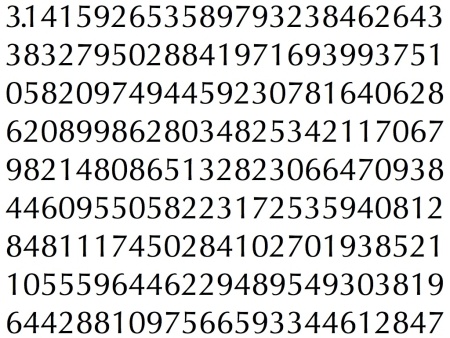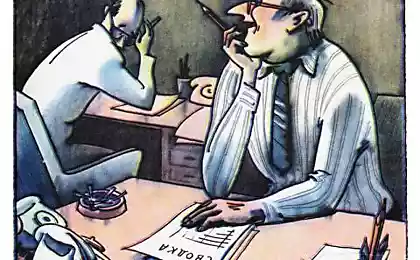1366
42 facts about the number π

Pi - the most famous constant in the mathematical world.
In an episode of Star Trek "wolf in sheep barn" Spock commands the computer foil "to calculate the value of the last digit of pi."
Comedian John Evans once quipped: "What do you get if you divide the circumference of a pumpkin lantern with slotted holes in the form of eyes, nose and mouth to its diameter? Pumpkin π! ».
Scientists Carl Sagan's novel "Contact" tried to solve a fairly accurate value of pi to find hidden messages from the creators of the human race and to open people's access to the "deeper levels of knowledge of the universe».
Symbol Pi (π) is used in the mathematical formulas for the past 250 years.
During the famous OJ Simpson trial disputes arose between the lawyer Robert Blasierom and an FBI agent on the actual value of pi. It was all intended to identify deficiencies in knowledge of civil service agent.
Cologne for men from the company Givenchi called "Pi", for attractive and far-sighted people.
We will never be able to accurately measure the circumference and area of a circle, because they do not know the full value of pi. This "magic number" is irrational, that is, its ever-changing numbers in random order.
In the Greek («π» (piwas)) and English («p») alphabets this symbol is located on the 16th position.
During the measurements, the size of the Great Pyramid at Giza was found that it has the same ratio of height to the perimeter of its base, the radius of a circle to its length, that is, 1 / 2π
In mathematics, π is the ratio of the circumference of a circle to its diameter. In other words, π number of times the diameter of the circle is equal to its perimeter.
The first 144 digits of Pi digits after the decimal point end 666, which are mentioned in the Bible as the "number of the beast».
If the calculated length of the equator of the Earth using π up to the ninth mark, the error in the calculations will be approximately 6 mm.
In 1995 Hiryuki Goto able to reproduce from memory 42,195 digits of pi after the decimal point, and still be considered valid champion in this field.
Ludolf van Zeil (rod.1540 - um.1610 gg.) Spent most of his life on the calculation of the first 36 decimal places of pi (which was the name of the "figures Ludolfs"). According to legend, these figures were engraved on his tombstone after death.
William Shanks (rod.1812-um.1882 gg.) Worked for many years to find the first 707 digits of Pi. As it turned out later, he made a mistake in 527 discharge.
In 2002, a Japanese scientist counted 1, 24 trillion digits of pi using a powerful computer Hitachi SR 8000. In October 2011, the number π has been calculated up to 10,000,000,000,000 decimal zyapyatoy
As 360 degrees in a full circle and pi are closely related, some mathematicians were delighted to learn that the numbers 3, 6, and 0 is three hundred and fifty-ninth digit after the decimal point in the number Pi.
One of the first mentions of the number Pi can be found in the texts of the Egyptian scribe named Ahmes (about 1650 BC. E.), Now known as the Rhind Mathematical Papyrus (Rind).
People study the number π for over 4000 years.
In the Rhind Mathematical Papyrus embodied the first attempt to calculate the number Pi to "squaring the circle", which is to measure the diameter of the circle to set up inside the square.
In 1888, a doctor named Edwin Goodwin said that he has "a supernatural value" accurate measure of the circle. Soon after the bill was proposed in Parliament on the adoption of which Edwin could publish copyright of their mathematical results. But this did not happen - the bill does not become law, thanks to professor of mathematics in the legislature, which proved that the method of Edwin led to another wrong value of pi.
The first million decimal places of pi in consists of 99,959 zeros 99,758 units, 100,026 pairs, 100,229 triples, quadruples 100230, 100359 fives, sixes 99548, 99800 sevens, eights and 99985 100106 nines.
Pi Day is celebrated on March 14 (was chosen because of the similarity with 3.14). Official celebration begins at 1:59 pm, in order to comply with the full accordance with 3/14 | 1: 59.
The value of the first of a number of Pi after first correctly calculated one of the greatest mathematicians of the ancient world, Archimedes of Syracuse (rod.287 - um.212 BC. E.). He presented a number in the form of several fractions According to legend, Archimedes was so fascinated by calculations that did not notice that the Roman soldiers took his hometown of Syracuse. When a Roman soldier approached him, Archimedes shouted in Greek: "Do not touch my circles!". In response, the soldiers stabbed him with a sword.
The exact value of pi was obtained Chinese civilization much earlier than the west. The Chinese have two advantages in comparison with most other countries in the world: they used the decimal notation and zero character. European mathematicians as time on the contrary did not use a symbolic notation zero in computing systems to the late Middle Ages until it came into contact with Indian and Arab mathematicians.
Al-Khwarizmi (the founder of algebra) worked hard to calculate the number Pi and won the first four numbers: 3, 1416. The term "algorithm" is derived from the name of this great Central Asian scholar, and its text Kitab al-Jabr wal Mugabala appeared the word "algebra ».
Ancient mathematicians attempted to calculate Pi, each time inscribing polygons with more sides that are much more closely fit into the area of a circle. Archimedes used a 96-gon. Chinese mathematician Liu Hui wrote a 192-gon and then 3072-gon. Tsu Chung and his son managed to accommodate a polygon with 24,576 sides
William Jones (rod.1675 - um.1749) introduced the symbol «π» in 1706, which was later popularized in the mathematical community Leonhard Euler (rod.1707 - um.1783).
Pi symbol «π» was used in mathematics only in the 1700s, the Arabs invented the decimal system in 1000, and an equal sign "=" appeared in 1557.
Leonardo da Vinci (rod.1452 - um.1519) and artist Albrecht Durer (rod.1471 - um.1528) had small developments on "squaring the circle", that is owned by an approximate value of pi.
Isaac Newton calculated pi to 16 decimal places.
Some scholars argue that people are programmed to find regularities in everything, because the only way they can make sense of the world and ourselves. And that is why we so attracted to "natural law" pi))
Pi also be referred to as a "circular constant", "constant Archimedes 'or' number Ludolfs».
In the seventeenth century the number Pi has gone beyond the circle and began to be applied in mathematical curves, such as the arch and the hypocycloid. It happened after the discovery that in these areas, some values may be expressed in terms of the sheer number Pi. In the twentieth century the number Pi has already been used in many mathematical fields such as number theory, probability and chaos.
The first six digits of Pi (314159) in reverse order, at least six times among the first 10 million decimal places.
Many mathematicians claim that the right is the wording: "circle - a figure with an infinite number of angles».
Thirty-nine decimal places of pi in enough to calculate the circumference of a circle encircling space objects known in the universe, with an error of not more than the radius of the hydrogen atom.
Plato (b. 427 - um.348 years. BC. E.) Got quite an exact value of pi for its time: √ 2 + √ 3 = 3, 146.























